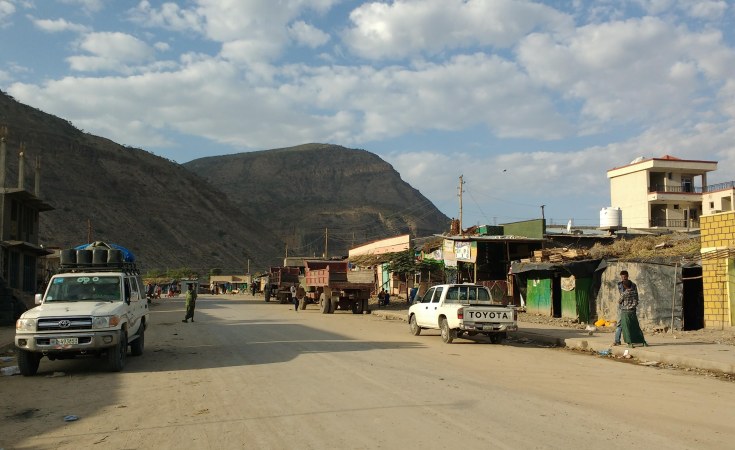Abala -- a border town between Tigray and Afar -- embodies the Tigray conflict like no other. Residents who used to be neighbors now accuse each other of committing massacres.
Decimated houses, as far as the eye can see, are the welcome sight that greets one while entering the town of Abala on the Tigray-Afar border. It feels like a ghost town in a Sci-fi movie.
In December 2021, Tigrayan fighters loyal to the Tigray People's Liberation Front (TPLF) attacked Abala.
Survivors who remained in the town told DW the Tigrayan fighters went from door to door, looted, and destroyed everything they could find.
As a result, broken glass still litters the street, and graffiti is painted on every other door or wall that reads 'TDF' (for Tigray Defence Forces) or 'Tigray winner.'
In some cases, other graffiti reads 'Afar' -- probably left behind by Afar militias, who staged a counter-attack on TPLF.
Looting, killing, and raping
Tahir Hassen, the mayor of Abala, remembers the day the TPLF came into his town: "They were firing heavy weaponry onto the city like rain," Hassen told DW, alleging that more than 225 people died as a result.
"They killed the elderly in their homes and others while they were escaping. Then, they followed them and killed them." They also raped five women."
He said those who stayed lived under the TPLF occupation for four months.
At a nearby cemetery, Mohammed Hussein, a local health official, showed DW mass graves. He said he had helped bury 58 civilians, among them eight children.
"These children were killed by shelling coming from TPLF. They were four, five years old and the oldest was six. I have a heavy heart. I will never forget this."
Even the elderly are not spared
"At the time, my son and I, as well as another elderly woman, were here together. I couldn't run because I am frail, I couldn't pay for transportation either because I didn't have money." Abeba, one of the displaced persons, told DW.
Abeba (not her real name for fear of reprisals) stayed, but the TPLF fighters confined her for two days in a detention camp. When she returned to her house, she found it in ruins.
"I am sure they will come back," Abeba said fearfully. "They told us if they feel threatened, they will come back."
Since March, afragile ceasefire between the federal government and the TPLF has been in place. In late April, TPLF fighters withdrew from Abala and other Afar territories, allowing aid convoys to enter the Tigray region.
But Abala's mayor Tahir Hassen says that TPLF never really left.
"They will come back once they have had enough food aid. When they've had enough, they will use [the aid] for war."
Massacre allegations
Abala had a mixed population of ethnic Tigrayans and Afar living together as neighbors, friends, and family. But now, both sides accuse each other of committing atrocities.
Tigray witnesses told DW that the Afar militia targeted and killed several Tigrayans. "Afar forces together with Afar residents shot Tigrayans and burnt their houses. They were targeting Tigrayans only," one witness, who wished to remain anonymous, said.
He said he only survived because his neighbor, an ethnic Afar, hid him in his house. "I was saved while other residents were killed." Another former resident said he had seen dead bodies of other Tigrayan residents he knew lying on the street.
Then they were told by Afar Special Forces that for their safety, they would be taken to the regional capital of Semera. Instead, the Afar fighters transported several thousands of them on lorries to Semera, where they were held in a detention site for more than five months.
Deplorable camp conditions
Jean Bosco, Head of Field Office at UNHCR in Semera, confirmed to DW that the group of internally displaced persons (IDPs) who were moved from Abala to Semera were all of the Tigrayan ethnicity.
"The official information we got was [that they were moved] for their own safety -- which is understandable," Bosco said, adding that having a minority trapped in a conflict zone exposes that group to retaliation.
"But after moving them, is it valid to keep them in a detention-like condition?" the UNHCR official pondered. At least 70 people, including five children, have died in the camp due to a lack of medication and food.
DW was not allowed to visit the camp, and local authorities repeatedly declined interview requests.
According to a former detainee, some people could leave the camp by paying bribes of up to 20.000 Ethiopian Birr ($380, €363), money that most the IDPs don't have.
The UN says a new camp has recently opened to ease congestion by taking in hundreds of people from Semera IDP Camp, But even there, people are not free to leave.
The Tigray crisis erupted on November 4 when Prime Minister Abiy Ahmed ordered Ethiopian National Defense Forces to carry out a military offensive on TPLF regional forces. Abiy's move was in response to the TPLF attack on a federal military base in the northern frontier.
The clashes came after months of disputes between Abiy's government and TPLF leaders, who were once Ethiopia's dominant political party.
Since then, thousands have been killed, and more than 5 million people uprooted from their homes in 2021 -- the highest number of IDPs recorded in a year -- according to a recent report by the Internal Displacement Monitoring Centre.
Edited by: Chrispin Mwakideu


